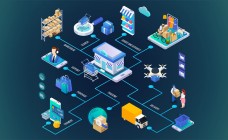How contactless payment is reshaping retail
October 18, 2024
“The emergence of technologies like wearable payment devices, biometric authentication, and IoT integration will further reshape how transactions occur, making payments not only touchless but also frictionless. This evolution will also impact store layouts and customer flow,” says Himaghna Dey Sarkar, COO of global tech solutions company ToneTag, in this exclusive column for Retail4Growth.
 Digital payments in India have become an everyday sight. Whether you're buying vegetables from a street vendor or paying for your morning coffee, a quick scan of a QR code or a simple tap-to-pay has become second nature. What started as a niche technology in the early 2000s has now become a core component of transactions everywhere. In India alone, over 200 million people regularly use contactless methods, driven by advancements in the country's digital payment infrastructure. PwC anticipates the deployment of 170 million QR codes by the end of FY 2025–2026. This transformation has reshaped the retail industry and set the stage for a fully contactless future by 2025.
Digital payments in India have become an everyday sight. Whether you're buying vegetables from a street vendor or paying for your morning coffee, a quick scan of a QR code or a simple tap-to-pay has become second nature. What started as a niche technology in the early 2000s has now become a core component of transactions everywhere. In India alone, over 200 million people regularly use contactless methods, driven by advancements in the country's digital payment infrastructure. PwC anticipates the deployment of 170 million QR codes by the end of FY 2025–2026. This transformation has reshaped the retail industry and set the stage for a fully contactless future by 2025.
Types of contactless payments
India’s retail ecosystem has seen a proliferation of various contactless payment systems, catering to different consumer needs. One of the most common is tap-to-pay cards, allowing consumers to complete purchases by simply tapping their card on a payment terminal. Mobile wallets, such as Google Pay and Apple Pay, have gained immense popularity among people from different age groups because of their seamless user experience These apps also offer users the convenience of storing card details on their smartphones, eliminating the need for physical cards.
QR code payments have become a normal part of everyday life in India. From buying groceries to booking tickets, scanning QR codes is now a seamless process for customers and merchants. Another innovation is WhatsApp Payments, which leverages the ubiquity of messaging apps to integrate payment options directly into conversations, making money transfers easier than ever before. Platforms like Route Mobile’s OmniCent offer specialized solutions, enhancing the capabilities of contactless payments through features like loyalty rewards and customer engagement tools.
Benefits to retailers
Retailers stand to gain significantly from adopting contactless payments. One major advantage is the enhanced integration opportunities that come with digital systems, particularly in marketing. Retailers can use data from customer transactions to launch targeted campaigns and improve personalization, driving more sales. Additionally, the hardware costs for implementing these solutions are minimal, especially when using QR codes or mobile wallet integrations. During peak hours, the faster transaction speed of contactless payments allows retailers to handle more customers, reducing long queues and improving overall efficiency. Moreover, the wealth of data collection and analytics from these payments allows retailers to make informed decisions about inventory management, customer preferences, and sales strategies, all of which help optimize their operations.
Benefits to customers
For consumers, contactless payments offer a host of advantages. The most obvious benefit is security. Payment methods like mobile wallets and UPI systems come with robust encryption and multi-factor authentication, ensuring that customers' money and data are protected. Additionally, faster payment processes enhance the shopping experience by reducing wait times at checkout counters, which is especially valuable in high-traffic stores.
Beyond speed, the overall shopping experience is improved as customers no longer need to carry cash or even physical cards.
Implementing contactless payments in Retail
For retailers looking to embrace contactless payments, the first step is assessing the current payment infrastructure. Retailers must determine if their existing systems can integrate new technologies like mobile wallets, QR codes, and UPI-based solutions. Choosing appropriate contactless solutions that align with customer preferences and business needs is equally important. Mobile wallets might appeal to a younger demographic, while QR codes offer versatility across customer bases. Staff training and customer education are crucial. Both employees and customers need to understand how to use these systems efficiently. Moreover, integrating contactless payments with existing systems, such as loyalty programs and inventory management, ensures seamless operations and enhances customer engagement.
Looking toward 2025, contactless payments will likely dominate the retail space even further. As digital infrastructures such as UPI continue to advance, contactless payment adoption is expected to rise exponentially. The emergence of technologies like wearable payment devices, biometric authentication, and IoT integration will further reshape how transactions occur, making payments not only touchless but also frictionless. This evolution will also impact store layouts and customer flow. With faster payment systems, retailers may prioritize self-checkout kiosks and smaller cashier areas, optimizing space for customer engagement zones or product displays. Integration with smart shelves and other IoT-enabled devices will allow customers to scan and pay for products instantly, streamlining the shopping experience even further.
By 2025, the retail industry is likely to see a comprehensive integration of contactless payments into every aspect of commerce. This transformation will be all powered by convenience, speed, and safety.


_165_265.jpg)
_165_265.jpg)


_140_270.jpg)


Comments